ciborium - A canopy, often free-standing and supported by four columns, erected over an altar. Also, a covered cup used in the sacraments of Christian churches.
(pr. sə-BOH-ree-əm)
Also see baldacchino.
cinematic montage - Motion-picture effects produced by superimposing separate, unrelated images or showing them in rapid sequence.
cinerary urn - A lidded vessel intended as the container for the ashes of someone who has died, especially one whose body has been cremated (incinerated).
Examples:

Etruscan, early 4th century BCE,
Reclining Youth, Cinerary Urn, bronze,
length of base 69 cm, height of figure 42 cm, State
Hermitage Museum, St. Petersburg, Russia. See Etruscan art.
![]()

![]()
Etruscan, Vignagrande, Cinerary Urn, mid-2nd century BCE,
terra cotta with traces of polychrome, Worcester Art Museum,
MA.
Also see sarcophagus.
cinnabar - A red. Literally, red mercuric sulphide, sometimes used as a pigment. It is the ore from which mercury is derived.
Example:

China, Jiangxi Province, Jingdezhen
Saucer (Die) Glazed in Imitation of a Fuzhou Chrysanthemum-Shaped Lacquer, Qing dynasty, Qianlong mark and period, dated 1774, molded porcelain with clear glaze, overglaze cinnabar and black enamel decoration, and gold inscription on reserved ground, height 1 1/4 inches (3.18 cm), diameter 6 5/8 inches (16.83 cm), Los Angeles County Museum of Art.
cinquecento - Italian, literally "five hundred," it refers to the 1500s — the sixteenth century. It is especially used to refer to Italian art of that century, the time of the High Renaissance and Mannerism.
(pr. CHEEN-kwə-CHAYN-toh)
Examples of works from the Italian cinquecento:
Sebastiano Mainardi (Italian, 1450-1513), Madonna and Child with Saint John and Three Angels, c. 1500, tempera on wood panel, 33 3/4 x 33 3/4 inches, Birmingham Museum of Art.
Leonardo Da Vinci (Italian, 1452-1519).

Michelangelo Buonarotti (Italian, 1475-1564),
David
, 1501-04, marble,
statue
 17
feet high, base
6 feet x 1 foot 5 1/4 inches x 1 foot 2 7/8 inches, Galleria
dell'Accademia, Florence. [
17
feet high, base
6 feet x 1 foot 5 1/4 inches x 1 foot 2 7/8 inches, Galleria
dell'Accademia, Florence. [detail:
the head] Michelangelo began work on the colossal figure
of David in 1501, and by 1504 the sculpture was in place outside
the Palazzo Vecchio.
Michelangelo and others, fresco paintings in the Sistine Chapel, Vatican, Rome. Michelangelo repainted the chapel's ceiling between 1508 and 1512. He later painted the Last Judgement over the altar, between 1535 and 1541.

Raphael (Raffaello Sanzio or Santi) (Italian,
Marchigian, 1483-1520), Madonna and Child Enthroned with Saints,
altarpiece, c. 1504, tempera
and gold on wood; main panel,
overall 67 7/8 x 67 7/8 inches (172.4 x 172.4 cm), painted surface
66 3/4 x 66 1/2 inches (169.5 x 168.9 cm); lunette,
overall 29 1/2 x 70 7/8 inches (74.9 x 180 cm), painted surface
25 1/2 x 67 1/2 inches (64.8 x 171.5 cm), Metropolitan Museum
of Art, NY. (On the Met's page, you can enlarge any detail.)

Titian (Tiziano Vecellio) (Italian, c. 1490-1576),
Danae,
1546/53, oil on canvas,
47 x 73 1/2 inches (120 x 187 cm), Hermitage Museum, St. Petersburg,
Russia.
Polidoro da Caravaggio (Italian, 1490/1500-1543)
Leone Leoni (Italian, 1509-1590) and Pompeo Leoni (Italian, 1533-1608).
Jacopo Robusti, "Tintoretto" (Italian, 1518-1594).
Paolo Caliari, "Veronese" (Italian, 1528-1588).
| Italian term | Numerically | English term |
|---|---|---|
| duecento | 1200s |
thirteenth century |
| trecento | 1300s |
fourteenth century |
| quattrocento | 1400s |
fifteenth century |
| cinquecento | 1500s |
sixteenth century |
| seicento | 1600s |
seventeenth century |
| settecento | 1700s |
eighteenth century |
| ottocento | 1800s |
nineteenth century |
| novecento | 1900s |
twentieth century |
| diecicento | 2000s |
twenty-first century |
circa - About, approximately. (From Latin.) Abbreviated c. and ca. Frequently used before approximated dates.
(pr. SER-kə)
Also see time.
Circular stage - Of Victor Lowenfeld's Stages of Artistic Development, the Circular stage is the third sub-stage of the first stage, the Scribble stage. The Scribble stage typically occurs at 2-4 years old. The Circular stage is characterized by further exploring of controlled motions demonstrating the ability to do more complex forms. Also see Preschematic stage (4-6), Schematic stage (6-9), Dawning Realism stage (9-11), and the Pseudorealistic stage (11-13).
Related link:
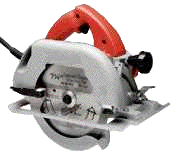
circular saw - A circular toothed blade which is power driven. Shown here is a hand-held model. A bench circular saw is used for cutting timber by feeding the wood into the blade, to cut across or down the length.
Also see carving, crosscut saw, kerf, and ripsaw.
![]()
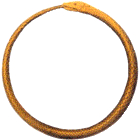
![]()
circumference - The length of a line that is at the outside edge of a circle; the periphery of a circle. The mathematical formula for the circumference of a circle: two times pi (3.14159), or diameter times pi.
circumscribe - To draw a line or lines around something; to encircle, as when enclosing (perhaps a polygon or polyhedron ) within lines, curves, or surfaces. To determine the limits of; to define or restrict.
cire perdue - French for lost-wax casting.
(pr. seer payr-DOO)
Also see sincere.
ciseau - A chisel that cuts or engraves the surface of metal. From the French, and distinguished by them from a ciselet.
(pr. see-ZOH)
Also see tools.
ciselet - A chasing chisel or tracer which dents rather than cuts a metal surface. From the French, and distinguished by them from a ciseau.
(pr. SEE-zə-LAY
See tools.
cissing - In painting, an application of color that would have resulted in a flat area of paint (covering with an even thickness), but resulted instead in running streaks and bare spots, usually because of poor wetting of the surface.
(pr. KI-səng)
Also see dragging.
civilization - An advanced condition of intellectual, cultural, and material development in human society, marked by progress in the arts and sciences, the extensive use of writing, and the appearance of complex political and social institutions. Or, it may be the particular type of culture developed by a nation or region during a period of history. Those people and things which further the development of this condition are called civilized, or may be called civilizing influences.
Quotes:
Also see archaeology, chronology, ethnosphere, heritage, interdisciplinary, material culture, posterity, primitive, Prometheus, tradition, and vandalism.
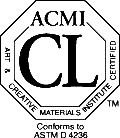 CL
- As
CL
- As ![]() often
seen in the "CL seal," when placed on manufactured
art materials by the Art & Creative Materials Institute
(ACMI), CL stands for "Cautionary Label," meaning
Not Recommended
for Use with Children 12 or under.
When used by older children, these products should be used with
caution and adult supervision is recommended.
often
seen in the "CL seal," when placed on manufactured
art materials by the Art & Creative Materials Institute
(ACMI), CL stands for "Cautionary Label," meaning
Not Recommended
for Use with Children 12 or under.
When used by older children, these products should be used with
caution and adult supervision is recommended.
ACMI says the satement "Confroms
to ASTM D-4236" indicates that the product conforms to the
labeling standards of the Hazardous Art Materials Act. If the
product is non-toxic, then no warning needs to be included on
the label. "However, if the product is found to carry acute
or chronic health hazards, the information on the label must alert
the consumer to those hazards."
Under US law, hazard-labeled products (CL Seal and warnings) may not be purchased for use by children grades pre-K through 6. Products that are labeled "Keep Out of Reach of Children" should not be used by young children, even with adult supervision, in schools. ACMI urges that all products meant for children's use be non-toxic. Only 15% of the adult materials ACMI has analyzed has been found to require hazard labeling.
Also see AP, ASTM International (American Society for Testing and Materials), hazardous, Material Safety Data Sheet (MSDS), Occupational Safety and Health Administration (OSHA), poison, safety, science and art, and seal.
clad - To produce cladding.
cladding - A decorative, protective, or insulating layer attached to the outside of a building or other structure. Various metals and stones are often used for cladding. Examples include steel, aluminum, limestone, and marble. Also, a technique of construction with wood: a solid shape is formed by bending thin sheets of Masonite or plywood over a wooden framework.
Also see veneer.
clamp - In architectural construction, a device, usually metal, used to hold together blocks of stone of the same course. Also called a cramp.
Also see adhesives.
class - A number of objects that have been grouped together because of common characteristics.
Also see assessment, order, pattern, sequence, standards, taxonomy, thematic, and typology.
classical - This term has come to have several meaning. Originally it was used when referring to the art of ancient Greece produced during the fifth and fourth centuries BCE. Later it included all works of art created from 600 BCE until the fall of Rome. Still later it was used to describe any art form thought to be inspired or influenced by ancient Greek or Roman examples. Today, classical is used to describe perfection of form, with an emphasis on harmony and unity and restraint of emotion. Usually, it is applied to works that are representational but idealistic. Classic is used to describe anything which is the epitome of its type.
Also see Greek art, neoclassicism, and Roman art.
classical orders - In architecture, five types of designs for columns. Three were developed in ancient Greece and adopted by the Romans: Doric, Ionic and Corinthian. Two were introduced by the Romans: composite and Tuscan. Each column has a shaft, capital, and entablature; and with the exception of the Doric, each has a base.
Examples:
A schematic diagram of the Doric order and a diagram of the Ionic order.
Related site:
Also see Greek art and Roman art.

![]()

claw chisel - A stoneworking chisel with the blade fashioned into small teeth. It is used for shaping and leaves striations in the stone surface. A "dente di cane" (Italian for "dog's teeth") is type of claw chisel having six or so fine notches in its carving edge. A claw chisel with two long points is know as a calcagnolo (Italian) or as a pied de biche (French). Also see bush hammer and drove.
claw hammer - The head of a claw  hammer has a flat
striking face on one side and two heavy metal
prongs on the other used to trap and lever out nail
heads.
hammer has a flat
striking face on one side and two heavy metal
prongs on the other used to trap and lever out nail
heads.
An example of are in which a claw hammer is important:
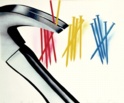
James Rosenquist (American, 1933-), Pulling out, 1972, color lithograph, 26/39, 65 cm x 76.5 cm,
Tehran Museum of Contemporary Art, Iran. Rosenquist pictures
a claw hammer pulling nails that he's
rendered in the primary
colors. See Pop
Art.
Also see ballpein hammer, bush hammer, join, and mallet.
clay - Mud; moist, sticky dirt. In ceramics, clay is the basic material, usually referring to any of a certain variety of mixtures of such ingredients — fine-grained, firm earthy material that is plastic when wet, brittle when dry, and very hard when heated. There is a temperature with ceramic clays at which their particles fuse (vitrification), and this is most commonly controlled by heating (firing) them in a kiln. The most common types of ceramic clays are earthenware (terra cotta when fired, terra cruda when not), stonewares, and porcelain. Also, a hardening or nonhardening material having a consistency similar to clay, often called modeling clay or Plasticine, and others including polymer clay.
Examples of works in unfired clay:
Mesopotamia (possibly Nippur. Ur III, c. 2044 BCE), Tablet in an Envelope, clay, Michael C. Carlos Museum, Emery U, Atlanta, GA. A writer who wished to prevent tampering with a letter or another important text sometimes wrapped it, as this one was, in a clay envelope on which the writer re-recorded the text and applied a seal. Any effort to tamper with such a message would then be discovered.
Michelangelo Buonarroti (Italian, 1475-1564), Model for a Victory, also known as Hercules and Cacus (Ercole e Caco), c. 1508?, clay, height 26 1/2 inches (41 cm), Casa Buonarroti, Florence.
Honoré Daumier (French, 1808-1879), François-Pierre-Guillaume Guizot, 1831, terra cruda (unfired clay) bust painted with oil, 22 x 17 cm, Musée d'Orsay, Paris. See caricature and French art.
Also see adobe, argilaceous, ceramics, coated paper, filter, firing, leather-hard, sand, slip, and terra cruda.
cleaning art - Dirt makes the surfaces of objects look shabby, and can cause them to deteriorate as well. Art conservators advise not touching the front or back surfaces of oil paintings, because this can cause cracks and other damage. Do not apply cleaning solutions, solvents, sprays, or insecticides near any work of art. Use a soft natural-bristle brush to clean objects and paintings when the surfaces are in good condition. Even feather dusters are not recommended, because feathers can catch in small cracks and dislodge fragments of paint or surface. Traditional advice for the cleaning of a painting's surface is to very gently rub it with a wad of white bread.
Also see art conservation, blot, caustic, clean up, eraser, hazardous, preparator, stain, stain removal, and volatile.
cleaning, clean up, cleansing - To make oneself and 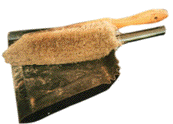 one's
environment clean, orderly and presentable. For instance, when
one has dirtied or disordered a studio
space that others will need to use, one must clean it up before
those others arrive. And, before it interferes with one's own
work!
one's
environment clean, orderly and presentable. For instance, when
one has dirtied or disordered a studio
space that others will need to use, one must clean it up before
those others arrive. And, before it interferes with one's own
work!
Also see abrasive, absorbent, art conservation, blot, caustic, cleaning art, detergent, detritus, eraser, filter, hazardous, pickle, solvent, stain and stain removal, toxic, volatile, water-soluble, and xylene.
clearstory - See clerestory.
cleave, cleavage - To cleave is to split or divide. Curiously, "cleave" can also bear the opposite meaning: to adhere closely, cling, stick.
"Cleavage" is sometimes used to refer to the partial separation or flaking of paint from a canvas, ground, or other layer of paint. Flaking usually reflects a breakdown in adhesion between the paint layer and the support. The problem may be inherent in an artist’s choice of materials or may result from the deterioration of the glue size in the ground. Such conditions are aggravated by seasonal or artificial climate control changes in temperature and relative humidity. The support expands under humid conditions and contracts under dry ones. As a paint film ages it loses its elasticity and becomes even more susceptible to flaking, cracking and cupping. In treating flaking paint, an art conservator typically infuses an adhesive into the flaking area and applies weight during the adhesive's setting period.
Also see carve, chisel, and hygrothermograph.

clerestory or clearstory - In architecture, this term (spelled either way) refers to a wall of a building which is raised above an adjoining room, and this section of wall has windows. The walls of the nave in a Christian church are higher than the roof over the side aisles, for example, and the clerestory contains windows for light and ventilation. Because of the heavy walls, the clerestory windows of a Romanesque church were small and admitted little light. Development of the pointed arch, piers, and flying buttresses in the Gothic cathedral made possible the enlargement of this window area.
(pr. KLEER-stə-ree)
Also see aisle, crocket, fenestration, glass, stained glass, and vault.
cliché - An idea or expression that has lost its originality or its force, and become trite because of its overuse. A stereotype. Most clichés become popular over the years because they express a thought aptly and concisely, when, if used too often, their aptness can be overwhelmed by their dullness.
(pr. klee-SHAY)
Quotes:
climate control - The ability to adjust and regulate the temperature and relative humidity in a particular environment. Climate-controlled vans and other means of conveyance are capable of adjusting and regulating temperature and relative humidity within certain limits.
Also see art conservation, cleavage, condensation, hygrothermograph, museum, silica gel, storage, and thymol.

clip art - General illustrations, figures, and designs that can be purchased free of copyright restrictions on printed sheets or as digital images, when the use of new art is too costly or otherwise inconvenient.
Also see baby spot, dingbat, dry transfer graphics, and vignette.
clock - See horology.
cloisonné - Enamels fused inside a wire enclosure (a cloison) on a metal or porcelain ground, forming chambers (cloisons) to receive vitreous enamel pastes. Used earliest and commonly by the Byzantines, with excellent examples dating from before the eleventh century. A rarer type of cloisonné is that in which the wire enclosures surround inlaid stones.
(pr. KLWAH-zə-NAY)
Examples of these two types:
Egypt, c. 1264 BCE (19th Dynasty), Cloisonné Pendant in the Form of a Predatory Bird with a Ram's Head, Serapeum of Sakkara, gold, turquoise, jasper, lapis-lazuli; span: 13.7 x 7.4 cm, Louvre.
Netherlands, second quarter of the 11th century, Maastricht Binding-Case, gold, cloisonné enamel, gemstones, filigree and niello on wood base, 0.392 x 0.32 m, Louvre.

Russia, Plaque
with the Virgin (and Plaque with St. Mark the Evangelist),
12th century, gold,
cloisonné enamel,
3.8 x 3 cm (and 4.5 x 2.9 cm), Hermitage Museum, St. Petersburg,
Russia. See plaque and Russian
art.

China, Nine Boxes Illustrating Stages in the Production of Cloisonné Enamel, about 1900-1925, bronze with cloisonné enamel decoration; cloisonné boxes (each): 2 3/8 x 1 5/8 x 1 inches (6.03 x 4.13 x 2.54 cm), Los Angeles County Museum of Art.
Also see champlevé.
cloisonnisme - Refers to the painting style of several French artists of the nineteenth century, reminiscent of the look of cloisonné enamel and stained glass windows.
Example:

Louis Anquetin (French, 1861-1932), Girl Reading a Newspaper, 1890, on paper, 54.0 x 43.2 cm, Tate Gallery,
London.
cloister - A covered walkway or ambulatory around an open court or garden. It was a common feature of medieval monasteries, connecting the monastery's church to its domestic parts.
(pr. KLOY-stər)
Examples:
Cloister of the Cathedral of Santiago de Compostela, 12th century, Spain.
Cloister of Canterbury Cathedral, 1397-1420, Canterbury, England. The cloister was designed by master mason Stephen Lote and constructed in the Perpendicular style.
Also see cathedral.
clone - Asexual reproduction or propagation of a biological organism. Scientists have successfully cloned various animals, leaving us concerned that human cloning will eventually follow. Used in discussing art, it evokes these developments.
Also see appropriation, copy, counterfeit, facsimile, forgery, multiple, reproduction, simulacrum, and trompe l'oeil.
closed shape - Space that is completely enclosed by a line, or unbroken contour. For example, a triangle is a closed shape.
Also see open shape and empty shape.
close-up - A photograph, film, or video shot in which the subject is tightly framed, and seen at a relatively large scale. A picture zooming in on a detail.
Example:

Abelardo Morell (American, born Cuba, 1948-), Farewell to Arms, 2001, close-up photograph of a page of Ernest Hemingway's book placed at an angle to the camera, with the lens's aperture opened to produce a depth of field which makes the nearest and farthest portions of the page out of focus. The photographer was interviewed about this image.
Also see enlargement, full-scale, overlap, size, wide-angle, wide-angle lens, and wide-angle shot.
closure - The recognition of meaning in an otherwise unclear or incomplete image, because the brain has been able to draw on previous experiences to discover sufficient similarity between the image and those memories. Bringing something to a conclusion.
Examples:

![]()

In these images, negative spaces have been shaped and placed among positive spaces so that a viewer can make closure on a triangle, a square, and a cube.


Here is an animation
of four pictures, each an arrangement
of colored squares
of decreasing size, increasing
number, and increasing complexity.
As the animation progresses there is a moment at which the viewer
identifies the image from which the images were derived.
This experience might be described
as achieving closure or making a new gestalt.
This experience is also likely to arrive earlier in the sequence
the more times one sees the animation. Even the final image is
actually a greatly distorted
reproduction of the original picture. See derived
image, metamorphosis,
and pixel.
For more examples of images inviting closure, see the titles of ArtPage's pages about words beginning with Sc-Sd and X,Y, and Z.
Also see coherence, gestalt, meaning, optical illusion, and projection principle.
![]()

clove hitch - A double-knot.
Also see macramé.
cluster pier - See compound pier.
CLUT - Acronym for color look-up table.
cm or cm. - Abbreviation for centimeter.
 CMYK - Cyan Magenta Yellow blacK. A system for reproduction
color in print
— "four-color printing,"
CMYK - Cyan Magenta Yellow blacK. A system for reproduction
color in print
— "four-color printing," 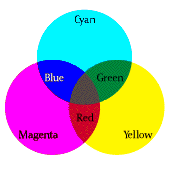
The diagram to the left shows some of the colors possible just with the first three of these colors. With the addition of black, the range increases further.
If you're a Web designer, you're used to working in RGB. Unfortunately, print graphics use either spot colors, usually CMYK or Pantone Matching System (PMS). You can use PMS colors (or spot colors) if your graphics have three colors or less (in reality, you can use them if there's more than three colors, but it's generally more cost effective to go to CMYK if you have more than three colors). Once you have at least four colors, it's time to go to CMYK. Keep in mind, though, that RGB colors tend to look much brighter and more saturated than either PMS or CMYK colors. To be able to show your client what your graphic will look like when printed, you'll need to get a Pantone swatch book that shows both RGB and CMYK colors. Pantone's ColorSuite for Internet will also help you ensure colors between print and Web.
Also see color
wheel.
https://inform.quest/_art